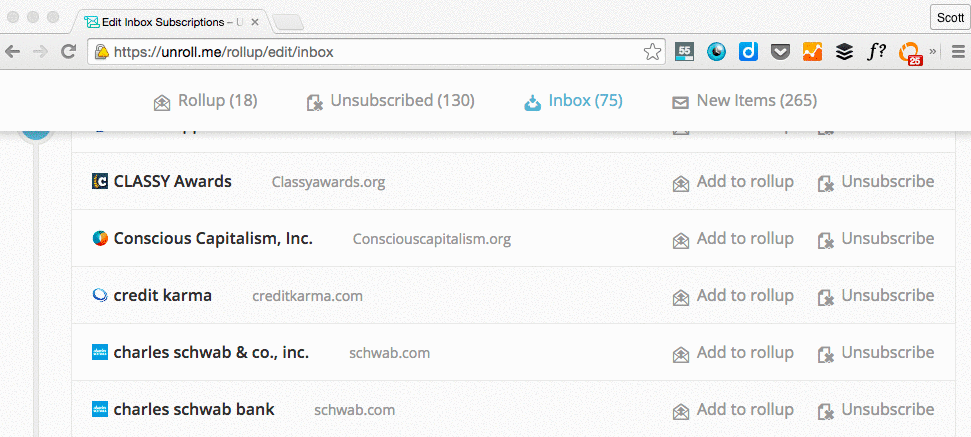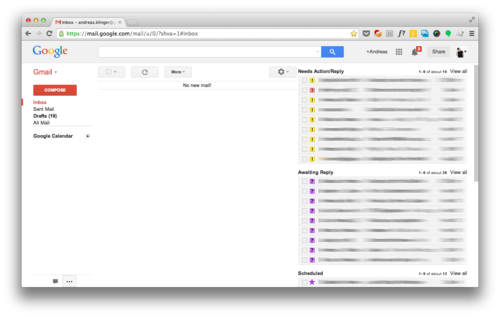5 guidelines to help you reach total inbox zen

La vostra mente è lo strumento più potente che avete. Dà un senso al mondo e funge da molla per la produttività e la creatività. Tuttavia, sappiamo tutti cosa succede quando va fuori controllo. La concentrazione viene compromessa, i livelli di stress aumentano e le notti sono insonni. Invece di essere un faro, la mente diventa un peso e inizia a lavorare contro di voi anziché a favore. È qui che entrano in gioco le tecniche di meditazione: per aiutarvi a trovare il segnale nel rumore, a calmare il disordine e a ricalibrare la vostra preziosa energia mentale.
Possiamo adottare un approccio simile quando si tratta di e-mail. Come la vostra mente, è uno strumento potente se siete in grado di gestirla invece di farvi gestire da lei. Una casella di posta indisciplinata, piena di messaggi non letti, pesa sulla vostra mente, distraendovi dai vostri obiettivi e ostacolando così gravemente la produttività.
It’s not just about getting rid of unprocessed emails; it’s about bringing a sense of peace to your inbox. Inbox zen rather than inbox zero. Just cleaning up your inbox and starting from scratch doesn’t cut it. You’re likely to be in the exact same spot in just a couple of weeks. As with many things, it’s about building powerful habits that will leave you with clarity of mind at all times.
Volete raggiungere e mantenere uno stato di benessere zen nella casella di posta elettronica? Ecco cinque linee guida per aiutarvi a iniziare.
1. Ridurre il rumore. Disdire l'iscrizione. Ora.
Review your email subscriptions and be honest with yourself about which ones bring actual value to you. If you’re tossing three emails in a row from the same sender, it’s time to say goodbye. It’s dirty work but it needs to be done and will fill you with a sense of relief afterwards.
That being said, unsubscribing from hundreds of email subscriptions can take forever. There are, of course, tools for that. My personal favourite is Unroll.me, a free tool that tracks and aggregates all of your email subscriptions so you can effectively unsubscribe from them in bulk. Just hook it up to your email account (Gmail, Outlook or whatever you’re working with) and start swiping away recurring junk. After you’ve unsubscribed from the stuff you don’t want, you can have the stuff you do want nicely packaged in the Rollup, one email featuring all your subscriptions. Done for the day.

While you’re busy doing spring cleaning with Unroll.me, be conscious and try to recognise patterns in the emails you’re getting rid of. This will make you more aware in future email management, keeping yourself from subscribing to newsletters that only add up to the noise.
2. Have your inbox do the heavy lifting
You’d be surprised of how powerful your inbox can be, even without any additional tools at all. I used to be one of those people who would literally crawl back in bed when laying eyes on my stacked inbox in the morning. That all changed when I came across Andreas Klinger’s methodology to keep your email inbox squeaky-clean at all times. “It takes about 15 minutes to set up, but might change how you work with email forever,” he claimed. I was skeptical at first, but have become a fan over time as it didn’t fail to deliver on its promise. It builds upon two native Gmail features: special stars and multiple inboxes. Since Klinger’s original post more than three years ago, I’ve seen a great deal of people using it.

Klinger’s method builds on the principles of Getting Things Done or GTD, the famous time management method laid out in David Allen’s book. What you’ll be left with is an easy-to-manage, usually empty inbox on the left, to-dos in the first box, emails ‘awaiting reply’ in the second one, ‘delegated’ emails in the third and the rest regarding meetings/flights/etc. easy to find in the fourth. You’ll have a perfect overview of the volume and nature of your workload and sales funnel at all times.
Here’s how Andreas handles day-to-day email management:
- Arriva un'e-mail
- Gestite quelli che potete immediatamente
- Gli altri segnano come da fare
- If you want to keep track of them when you replied, you mark them as “Awaiting Reply” or “Delegated” (that way you can always quickly find them and follow up)
- Archiviate tutte le e-mail
- La casella di posta elettronica a sinistra è di nuovo vuota
- Tutti quelli importanti si trovano nelle apposite caselle a destra
- That’s it. You’re done.
Sounds like a pretty great workflow, right? If you’re up for it, check out his step-by-step instructions to set everything up.
3. Put a clock on it
Are you one of those people who reads every email as soon as its notification pops up? Stop doing that. Every single one you open is a break of your workflow and a blow to your productivity. Your inbox shouldn’t be managing your time.
Instead, deal with emails in your own time. This is where the power of habit comes in. Email management is just another day-to-day productivity task that’ll greatly benefit from a little structure. Set a time frame to deal with your emails, a couple of times a day or once an hour.
You can use the Francesco Cirillo’s Pomodoro technique to stay in control of your email time slots. The Pomodoro technique is a way to use time efficiently, building on the idea that productivity decreases as you surpass a certain of time spent on a task. Consistently splitting up your time into task-focused blocks will train you in being more productive during each block. A pomodoro is a 25 minute block, followed by a 5 minute break, after you which you start with a 25 minute productivity block again. I personally dedicate two pomodoro blocks to email management each day: one in the morning and one in the afternoon. You can keep track of your pomodoros with Pomodoro Timing Apps. Zapier did a great job of packaging the best ones for you in this post.
4. Streamline team emails
Quante delle vostre e-mail vengono inoltrate dai membri del vostro team? Nonostante esista da ben 46 anni, l'inoltro delle e-mail è ancora il modo migliore per condividere le informazioni con gli altri. E gli account di posta elettronica condivisi? Un po' meglio, se non fosse che richiedono il passaggio dal proprio account e-mail a quello condiviso. La caratteristica intrinseca della posta elettronica di essere un silos di informazioni per una sola persona è una seccatura per la produttività del team e compromette le vostre ambizioni di raggiungere lo zen della casella di posta.
Out of your hands? Not quite. Hiver is a great tool that allows you to streamline and track all of your team communication across members. It lets you add shared inboxes to your inbox and share custom labels across the team. This means you can share emails with team members who weren’t an original recipient by adding a shared label to said email.
È anche possibile condividere modelli di e-mail tra i membri e aggiungere note alle e-mail per spiegare rapidamente agli altri cosa sta succedendo in un particolare argomento di e-mail. Le bozze condivise permettono di far finire a un compagno di squadra un'e-mail iniziata da voi. Sono inclusi anche i poteri di tracciamento delle e-mail.
The key takeaway of Hiver is that it allows you to tackle both your own and your team’s emails in one place and thus in one time block. This makes it perfect for collaboration within the workplace at your startup or small business. It’s a great way for your team to handle customer support, hiring, task management… Pretty much the stuff you wouldn’t create a sales pipeline for in your CRM but that still requires team effort.
Hiver’s free version lets you share notes, three labels and ten email templates with up to three others users. For more, check out their options.
5. Make a game out of it
If you’re not really feeling all of this zen stuff and would rather just get it over with, The Email Game may just very well be your next favourite thing. It’s a free tool for Gmail that, you guessed it, makes a game out of clearing out your inbox.
Once you’ve entered your email address, the game gives you about 5 seconds per email to decide what to do with it: reply, boomerang (archive now and have it resurface in your inbox later, at a specified time), archive, delete or skip. Every action gets you points and points get subtracted if you fail to act in time. Clicking reply will give you three minutes to respond. You can add time if needed, but be sure to keep up the tempo.
Come state cercando di mettere ordine nel caos delle vostre e-mail? Twitta con noi (@salesflare) con #inboxzen!
- I 20 migliori libri di vendita che Elon Musk sta probabilmente leggendo - 14 Febbraio 2023
- 6 modi infallibili per far ottenere alla vostra startup i primi 100 clienti - 6 dicembre 2022
- Come costruire un imbuto di vendita che venda - 2 Settembre 2021
